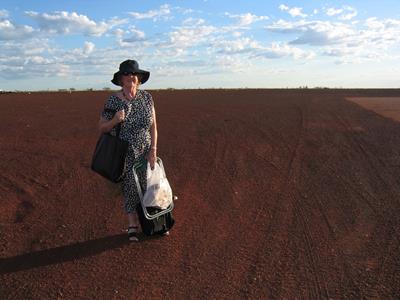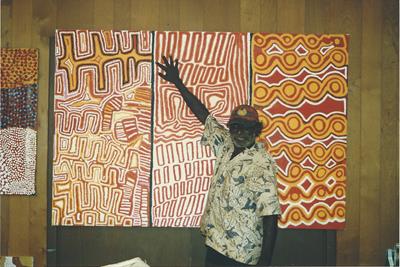WIRRIMANU (BALGO)
THE LAVERTY COLLECTION - PART III
5 April 2017, Sydney
The present day Wirrimanu Aboriginal Community at Balgo had its origin as a mission established in 1937 on ‘Rockhole Station’, near Halls Creek in the Kimberley region of Western Australia. For various reasons and ultimately because of problems with sustainable adequate water supply, the settlement was later, and more than once, moved further south. In 1965, it finally reached its lasting location at Balgo, on the edge of the Tanami and Great Sandy deserts. The great geographical isolation of Balgo is reflected in its being 850 kilometres north-west of Alice Springs and 270 kilometres south of Halls Creek. Most artists associated with Balgo live and work in the main Balgo settlement but some live at two other smaller outlying settlements – at Billiluna and Mulan.
The community was begun by German missionaries of the Catholic Pallottine Order, who provided succour and a degree of cultural understanding for a heterogeneous group of Aboriginal people displaced from various quite distant traditional Western Desert lands by expanding grazing and mining activity, by drought in the desert and gradually, over 30 years, by desire to join other family members at Balgo. The people spoke different languages but nevertheless shared social and cultural heritage and ceremonial values common to many desert groups. Body painting, sand drawing and ground painting were a vital part of their cultural activity. The relatively recent development of art for the market at the Balgo community is representative of what has happened in quite a number of remote Indigenous communities.
Non-traditional or ‘new, different’ art and craft activities began gradually and only later was a community art centre started. The art centre is owned and governed by the Aboriginal people and supported by advisors. Its aim has always been to provide social, cultural and economic benefit to the artists, their families and the community. Initially the enterprise received financial support from the government but at Balgo this was later withdrawn when the centre became commercially self-sufficient.
In 1971 the Australian Government had set up Aboriginal Arts and Crafts Pty Ltd as an agency to support and encourage the Aboriginal art market by facilitating painting and by purchasing and distributing works from remote communities. Mary Macha, a field officer employed by Aboriginal Arts and Crafts, visited Balgo to purchase works. As in many communities, ochres were used at first but these were soon replaced by acrylics, just as boards were replaced by canvases in ensuing years.
Sporadic ‘new’ painting on any available small wooden sheets or ‘boards’ occurred at Balgo in the mid to late 1970s, a few years after the beginning of the art movement at Papunya. The elders at Balgo had heard about the painting happening at Papunya but were concerned about the commercialisation of stories dealing with sacred-secret matters.
In 1980 Warwick Nieass, a European artist then living at Balgo, facilitated sandstone carving, but this activity was short-lived. The sisters of St John of God began adult education and art classes in 1981 and an ‘Art Centre’ funded by the Australia Council and overseen by Nieass operated for some months. The success of this program, and the enthusiasm with which local people participated, led the missionaries to request that the men paint large banners for the Jubilee celebrations of a local priest. These large banners were the first publicly exhibited paintings from Balgo.
In 1986/7 the first significant exhibition of Balgo art was organised by anthropologist Ronald Berndt and curator John Stanton in liaison with the Adult Education staff at Balgo. It was held at the Art Gallery of Western Australia where Michael O’Ferrall was curator of Aboriginal Art. Titled ‘Art from the Great Sandy Desert’, it had 105 individual acrylic works by 34 different artists, as well as two collaborative church banners. About equal numbers were on board or canvas, but by then there were no longer any ochre works, and acrylic painting on canvas had become the norm. Women, as well as men, were active as artists even at this early time for Balgo painting and of the 34 artists represented in the first show 12 were women. The anthropologists Ronald and Catherine Berndt, who had been visiting Balgo since the 1950s, wrote a very forward-looking and predictive introduction to the first exhibition catalogue. They recognised and stressed both the ethnographic importance and the secular contemporary attraction of the paintings, as well as the then largely unappreciated significance and interest of the work for all Australians. ‘Exhibited here,’ they wrote, ‘is a selection of paintings and drawings of great aesthetic significance. All of this work is contemporary. It is also uniquely Aboriginal, distinct in the Balgo style.’
The artists in this first exhibition included Mick Gill Tjakamarra, John Mosquito Tjapangarti, Eubena Nampitjin, Nancy Naninurra Napanangka, Wimmitji Tjapangarti, Sunfly Tjampitjin, Patrick Olodoodi Tjungurrayi and Tjumpo Tjapanangka, who all became very well known and respected artists. Eubena Nampitjin is still contributing significantly at Balgo as a senior artist and community leader and Patrick Olodoodi Tjungurrayi paints successfully at Kiwirrkura for Papunya Tula Artists.
Soon after this first exhibition, a community arts organisation was set up at Balgo in 1987. Named Warlayirti Artists Aboriginal Corporation, it had Andrew Hughes as its co-ordinator/arts advisor. Michael Rae followed in 1988/9, then came Robin Beesey and in the mid-1990s James and Wendy Cowan. John Oster and Julie Fielke were next, followed by Erica Izett and Tim Acker, then Samantha Togni and Stephen Williamson. Currently Sally Clifford and Annette Cock direct and manage the Art Centre.
Andrew Hughes, the first co-ordinator, later became art advisor at Maningrida on the coast in the tropical north, where there is plentiful water, fish, and fruit and vegetables. He retains great admiration for the Balgo desert people whose lives were so different and by comparison ‘so tough’.
Initially, like paintings from many other Central and Western Desert communities, the paintings from Balgo resembled Papunya paintings, but a recognisably ‘Balgo’ style continued to develop. Sometimes the painting of the iconic imagery and particularly the dotting appears ‘rough’ to non-Indigenous people. As a generalisation, dotting initially tended to be finer and more discrete than it is now, and it has evolved over time so that more recently the ‘smudged’ line of continuous dots and fields of merged dotting are more common. Singing, touching and social interaction were important components of the art making and understanding process.
Balgo paintings as a group have a multitude of meanings and significances because they have come from artists with very diverse backgrounds. For all, though, Tjukurrpa or ‘Dreaming’ has been the basis of the storytelling in art. These traditional narratives relate to far-distant homelands; to conceptual landscape mapping; to ancestral or Tingari itineraries; to the creation of landscape, lightning, rain, watercourses and waterholes; to the Rainbow Serpent and other sacred snakes; to animals and birds including dingos, the sacred dog Kinyu and the kingfisher Luurnpa; to various food gathering activities; to the sky and stars at night; to initiation rites and to Wati Kutjara (the travels in the Dreaming of twin brothers who were maparrn men or sorcerers, capable of magic).
The subject matter is difficult for non-Indigenous people to appreciate, because the artists have continued to innovate with their abstracted iconography while evoking or reflecting on stories of the Dreaming and of their often far-distant ancestral and family homelands. For the artists the cultural and storytelling aspects have been more important than the secular, aesthetic, abstract or artistic, though certainly there is now real understanding of market forces and what sells well to people used to looking at western art, especially abstraction. The evolving painting technique is complex and expressive and since the time of Michael Rae in the late 1980s the colours have been bright, vibrant and non-traditional, with painterly use of a wide range of colours, including reds, yellows, blues and greens.
Although there is debate about which aspects are most important, Balgo art has had appeal for anthropologists, art museum curators and contemporary art collectors. Balgo art is vibrant and strong contemporary art arising out of an art tradition spanning millennia. While recognisably from Balgo, very many artists such as Eubena Nampitjin, Boxer Milner Tjampitjin, Tjumpo Tjapanangka, Lucy Yukenbarri Napanangka and Elizabeth Nyumi Nungurrayi nevertheless made and continue to make, individually, very distinctive work.
Balgo artists were not represented in the very important overseas exhibition Dreamings: The Art of Aboriginal Australia at the Asia Society Galleries in New York in 1988, as Balgo painting was only just starting to be known at that time, but then neither were Rover Thomas of the Warmun community or Emily Kngwarreye of Utopia (these two being now probably the best known of all Australian Aboriginal artists). This just underscores how very recent the development of the contemporary Aboriginal painting movement is in Australia.
Paintings by Elizabeth Nyumi Nungurrayi were selected for the 2004 Biennale of Sydney and shown at the Museum of Contemporary Art as part of a large contemporary exhibition of work by artists from many countries. Indigenous artists from several remote communities and urban Aboriginal artists had been represented in previous Biennales, but this was a first for Balgo. It is also surprising that, although Balgo artists have been represented regularly in the very important annual Aboriginal and Torres Strait Islander Art Awards in Darwin, only Eubena Nampitjin has so far won an award – she won the open painting award in 1998.
Eight Balgo artists were represented in Mythscapes: Aboriginal Art of the Desert at the National Gallery of Victoria in Melbourne in 1989; five in the Aboriginal Art and Spirituality exhibition at the High Court of Australia in 1991; four in Contemporary Aboriginal Art from the Robert Holmes à Court collection which toured in the USA in 1999; four in the important Aratjara: Art of the First Australians exhibition which toured Europe in 1993 – 94; nine in Images of Power: Aboriginal Art of the Kimberley at the National Gallery of Victoria (also in 1993); two in Dreamings of the Desert: Aboriginal Dot Paintings of the Western Desert at the Art Gallery of South Australia in 1996; twenty-five in Paysages Rêves: Artistes Aborigènes contemporains de Balgo Hills (Australie Occidentale) at Centre de la Vieille Charité, Marseilles, in 2004; and recently two in Dreaming Their Way: Australian Aboriginal Women Painters at the National Museum of Women in the Arts in Washington DC in 2006.
COLIN LAVERTY (written 2008)
RETURN TO CATALOGUE

